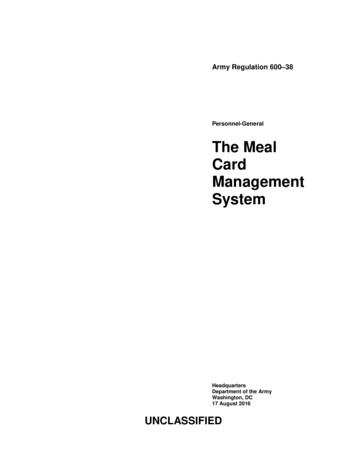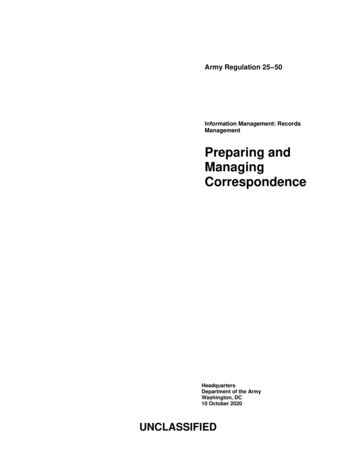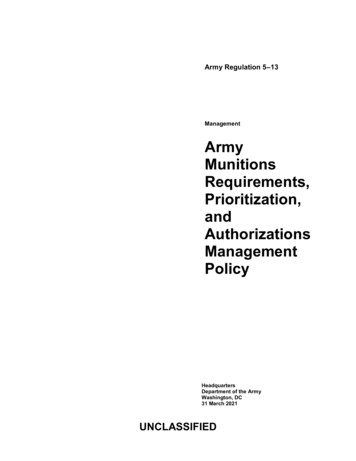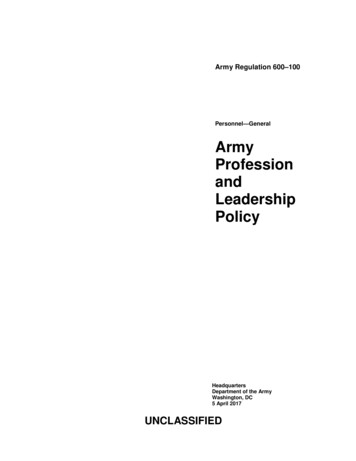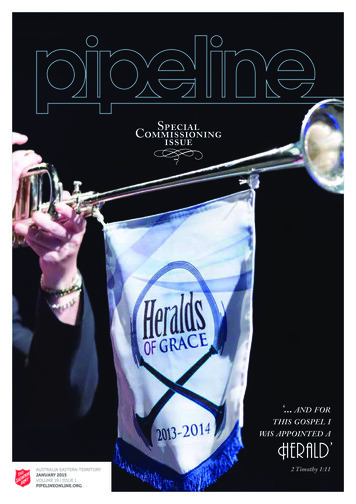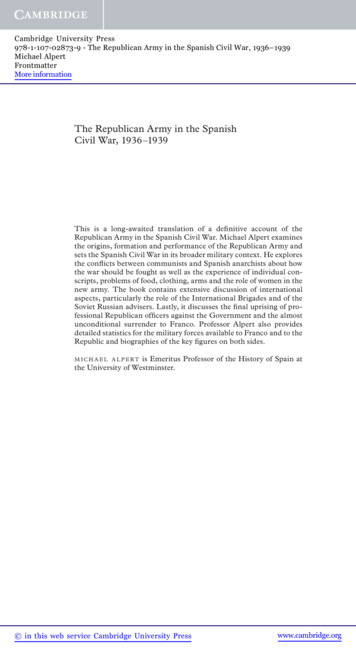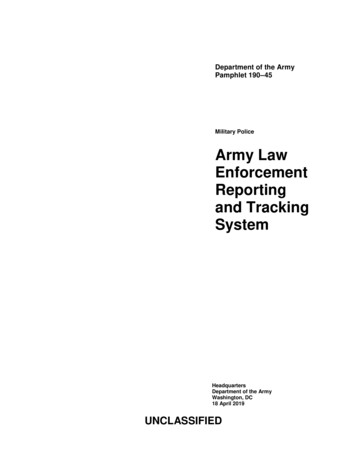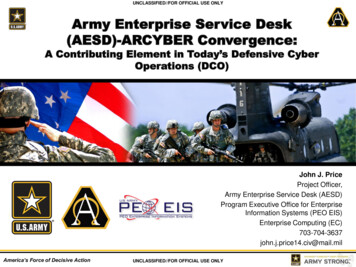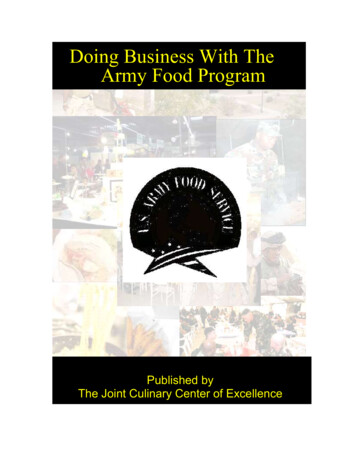
Transcription
Doing Business With TheArmy Food ProgramPublished byThe Joint Culinary Center of Excellence
Table of ContentsJCCoE History, Mission, Vision, Purpose and Organization03The Big 314The US CodeDefense Logistics AgencyDefense Logistics Agency Troop SupportJoint Subsistence Policy BoardArmy Deputy Chief of Staff, G4The Office of the Surgeon GeneralThe DOD Combat Feeding ProgramUS Army Quartermaster SchoolArmy Sustainment CommandSubsistence Prime VendorsInstallation Food Program Managers (FPM)Candidate Product Proceduresa.b.c.d.e.14Garrison Item ProceduresContingency Operations (CONOPS) Menu ProceduresFood Service Management Board (FSMB) AOROperational Rations ProceduresEquipment ProceduresOther Pertinent Information142224273435a. Berry Amendmentb. Federal Procurement List3536Summary37References38Glossary of Acronyms39Glossary of Terms432
JCCoE History, Mission, Vision, Purpose, and OrganizationHistory: In February 1989, the Chief of Staff, Army directed the formation of theArmy Center of Excellence, Subsistence (ACES) by merging two organizations;the Directorate of Food Service, U.S. Army Troop Support Agency, Subsistenceand Food Service Department, and the Quartermaster School (QMS). ACESofficially began with the completion of asset transfer on 1 October 1989, at FortLee, Virginia. On 1 October 2009, ACES re-aligned under the SustainmentCenter of Excellence (SCoE) as the Joint Culinary Center of Excellence(JCCoE), which is divided into three directorates; Army Center of Excellence,Subsistence Operations Directorate (ACES OD), Joint Culinary TrainingDirectorate; which is now the Joint Culinary Training Center (JCTC) and SpecialPrograms Directorate (SPD).Mission: Provide United States Armed Forces joint proponent culinary trainingand serves as the DAG4 Lead Agent for the Army Food Service Program.Vision: Be the Corporate Headquarters for Army Food Service. Serve as Leadagent for the Army’s Deputy Chief of Staff, Department of the Army (DCS DA) G4and the Army Quartermaster General for Army Food Service Programsworldwide. Be the premier Joint food service training institution for the ArmedServices in both entry-level and advanced culinary training. Maintain andcontinuously improve in the recognition of food service excellence in specialactivities and programs such as the Philip A. Connelly Award.Purpose: Ensure our mission and vision statements are accomplished. Tomeet these objectives; we serve as the Soldier advocate and lead agent for theentire Army Food Program including training and operations for both garrison andfield feeding; develop new feeding concepts for the Army Food Program; developstandards for menus and operational rations; write regulations and doctrinalpublications; implement policies for both active and reserve components;establish effective food safety, dining facility design, food service equipment andfood service management oversight methods and principles; represent the Armyin the joint arena as a voting member in Department of Defense (DoD) FoodProgram Committees. Evaluate current and proposed food systems; identify andanalyze deficiencies and shortfalls; seek solutions to remedy these deficienciesand shortfalls; administer Army Food Program competition and recognitionprograms and train enlisted Soldiers in the entire scope of the Army FoodProgram, including garrison and field feeding.Organization: JCCoE consists of three directorates, as seen below in Figure 1.These are the ACES OD, JCTC, and SPD. The JCCoE Director is responsiblefor all the activities of JCCoE and represents the Department of the Army (DA)G-4 and the Quartermaster General (QMG) at various government and industryboards, committees, and meetings. Aligned under the JCCoE Director are the3
JCCoE Sergeant Major (SGM), JCCoE Executive Officer (XO), and the ArmyFood Advisor (AFA). The JCCoE SGM is the highest level food service NonCommissioned Officer (NCO) in the Army and handles specific food serviceenlisted and NCO issues. The Executive Officer (XO) supports and assists theJCCoE Director when needed and is the Director of the Special ProgramsDirectorate. Additionally, the XO provides administrative and supply support tothe JCCoE staff. The Army Food Advisor (AFA) is the highest level food servicewarrant officer in the Army and serves as the primary technical and tactical foodadvisor to the JCCoE Director, QMG, and the DA G4. The AFA, as the seniorfood service technician, provides mentorship in the development and educationof other food service warrant officers.Figure 1. JCCoE Organizational ChartSpecial Programs Directorate: The JCCoE Special Programs Directorateadministers the Department of Army Philip A. Connelly Awards Program forExcellence in Army Food Service, commonly referred to as “The ConnellyProgram” or just “Connelly”, The Army Culinary Arts Program consists of theAnnual Military Culinary Arts Competitive Training Event, U.S. Army Culinary ArtsTeam, Enlisted Aide Competition, and the 92G Credentialing Program. The“Connelly” program exists as a partnership between the Army and the NationalRestaurant Association (NRA), whose members assist in judging the winners.The Connelly Program recognizes excellence in Army Food Service from topperforming units to include the U.S. Army Reserve (USAR) and Army NationalGuard (ARNG) competing at the Army level in one of three categories: MilitaryGarrison, Active Army Field Competition, and Reserve Component Field4
Competition. In order to compete at the Army level, the units must have beenwinners at installation and regional competitive programs. Connelly competitorsare judged on food preparation and serving skills, food management, training,subsistence accountability, sanitation, security, safety, equipment maintenanceand many other areas depending upon the category of competition.The U.S. Army Culinary Arts Team (USACAT) is the U.S. National MilitaryCulinary Team and will compete at local, national, and international culinarycompetitions. The Commanding General, QMS appoints the team manager andmembers. Appointments are accomplished by memorandum to the respectivecommands. Team members will be appointed for a specific time period that willbe noted in the appointment memorandum. The purpose of USACATcompetitions is to offer the military chef opportunities to sharpen and broaden hisor her cooking skills. USACAT members are obligated to share knowledge withwhoever wishes to learn. This ultimately benefits the military diners in troopdining facilities in garrison and on the battlefield.The Annual Military Culinary Arts Competitive Training Event is sanctioned byThe American Culinary Federation (ACF). Medals earned from federation entriescan be used towards 14 various levels of ACF chef certifications. Thecompetition is open to active duty members of all Services, DOD civilians, andUSAR and ARNG personnel.The Enlisted Aide Competition was established to identify and reward the topEnlisted Aides in the Army and promote the Enlisted Aide Training Course. Thecompetition includes four phases, consisting of an Enlisted Aide Hot FoodChallenge, a Uniform Assembly Challenge, Leadership Board, and a WrittenExam.The 92G Credentialing Program is a partnership between the U.S. Army and theAmerican Culinary Federation. The credentialing program is designed to providethe Soldier with all the educational materials required for the two-year program,including textbooks, training logs and forms for tracking individual progress. Allitems are included in the tuition. The program is registered with the U.S.Department of Labor Bureau of Apprenticeship and Training and is approved forveteran’s benefits.Joint Culinary Training Center (JCTC): The Joint Culinary Training Center(JCTC) serves as the principal advisor to the Director, JCCoE; USAQMS and theQMS Commandant on all issues involving entry level and advanced culinarytraining. The JCTC is responsible for the development, management, andoversight of Army and Joint Services basic and advanced culinary trainingprovided for all branches of the Armed Forces of the United States. Annuallytraining is approximately 5,000-6,000 Soldiers, Marines, Sailors, Airmen, CoastGuardsmen, DoD civilians, and members of other allied countries in basic and5
advanced food operations skills, subsistence and food service equipmentoperations for garrison and field training.The JCTC consists of three divisions responsible for Initial MilitaryTraining/Advanced Individual Training (IMT/AIT), advanced culinary, andinternal/external special skills training. The JCTC conducts initial entry training(IET) for the Army’s military occupational specialties (MOS) Culinary Specialist(MOS 92G), and consolidated training for United States Marine Corps (USMC)Food Service Specialist (MOS 3381) and United States Navy (USN) CulinarySpecialist (MOS 0013). The JCTC is also the Army’s trainer for functional andAdditional Skill Identifier (ASI) producing programs including: Advanced CulinaryTraining Course, the Enlisted Aide Training Course, and the Food ServiceManagement Course.The JCTC develops and executes resident and nonresident training in field andgarrison culinary for the Total Army. JCTC provides all logistical andconsolidated training development functions to support Marine Corps and NavyCulinary/Food Service Training under Interservice Training Review Organizationand manages the development of new training methodology to include distancelearning, TNET capability, and commander networking.Army Center of Excellence, Subsistence Operations Directorate (ACESOD): The Director of Operations (DOO), ACES under the authority of the ArmyG-4, oversees the operational side of the Army Food Program by providingpolicy, doctrine, standards, direction, and management assistance to Armycustomers worldwide, including the Army Reserve and Army National Guard.The ACES OD is divided into five divisions, as show in Figure 2. These fivedivisions are: Management Assistance Division, Facilities and EquipmentDivision, Quality Assurance Division, Concepts, Systems and Policy Division andthe Army NG/Reserve Division.6
Figure 2. ACES OD Organizational ChartManagement Assistance Division (MAD): The MAD provides managementreview of operations and training assistance to Army installation Food Programsand dining facilities around the world. While some of this review, advice andassistance is provided from the office at Fort Lee, most is accomplished throughthe use of Food Management Assistance Team (FMAT) visits conducted on-site.FMAT will normally visit CONUS regions or installations every 18 months at aminimum and OCONUS locations every 12 months. Additional visits may berequested by the installation to address specific concerns and issues. The FMATreviews the following areas, providing technical guidance and training as neededto ensure regulatory guidance: administration; subsistence accounting andinventory management; food preparation and serving; food protection andsanitation; menu standards; personnel management; contracting and contractsurveillance; utilization, dining facility construction and renovation; equipmentreplacement and maintenance and Prime Vendor Program issues.Facilities and Equipment Division (FED): FED provides advice and assistanceto units and installations in all areas of food service equipment specifications andmaintenance. FED reviews performance specifications for new garrison foodservice equipment and makes equipment recommendations to the user, who inturn makes the final purchasing decision. In additional, FED is theQuartermaster proponent for the Defense Standardization of Army Field FeedingFood Service Program and provides input to Sustainment Center of Excellence(SCoE) and NATICK for new development of specifications, new technologies7
and descriptions and equipment selection. FED serves as Joint Technical Staffto the Voting member for the Army on the selection board for all approved fieldfeeding food service equipment and assists in the development of policy anddoctrine; consults with US Army Soldier System Center, NATICK, Joint Center ofExcellence (JCCoE) Army Center of Excellence Subsistence (ACES) OperationDirectorate (OD) Concepts, Systems, and Policy Division on all matters oftactical, garrison and field regulations. In addition, FED serves and supports theUS Army Center for Health Promotion and Preventive Medicine as a SubjectMatter Expert (SME) for the Army Technical Bulletin Occupational andEnvironmental Health Food Sanitation manual (TB MED 530/NAVMED P-50101/AFMAN 48-147 IP) Tri-Service Food Code for facilities and construction; openand closing inspection criteria; Oversight of the Common Table Allowance (CTA)50-909 for Army food service equipment and submits the Army budgetrequirements for the Military Construction, Army (MCA) dining facility projects forthe government furnished and government installed food service equipment,decoration and furniture items.An essential part of the FED mission is to work with the Army Corps of Engineers(COE) in the areas of new MCA, and renovation project management. FEDserves as the lead JCCoE consultant on facility design, techniques, andmethods, construction methods, specifications, contractor quality assuranceprogram, life safety code principles and design/construction criteria worldwide.Monitor food service and Subsistence Supply Management Office (SSMO)equipment for installations worldwide. Plan/program funds for the acquisition ofequipment in support of food service/SSMO operations. Develops and revisesregulatory material. Provide technical advice and guidance on the validation offood service/SSMO equipment requests. Conduct periodic visits to installationsto evaluate the food service/SSMO facility/equipment and facilities programs.Assign subordinates to serve on Food Management Assistance Team (FMAT).Supervises budgeting formulation, justification and execution of field feedingequipment acquisition, MCA provided equipment and décor packages. DevelopsPOM cycle budget requirements for MCA Government provided equipment anddécor for Army DA G4, ASC and IMCOM HQs.The division works closely with Army Reserve and National Guard COE on newMCA and renovation projects. The Army is looking into different ways ofdesigning and building Army dining facilities. Construction costs are on the riseand Soldier strength is increasing at various installations Army-wide. The Armyis transforming in so many ways, and as a result, the Military Construction(MILCON) process must transform to remain relevant.In cooperation with the COE, JCCoE explores ways to streamline design andconstruction processes and reduce overall costs of building and furnishing diningfacilities. The Army COE and JCCoE are exploring corporate business modelsand trying to emulate these models to gain an understanding of their construction8
procedures. Army COE has recently sponsored MILCON /TransformationIndustry Forums to meet with the industry leaders in architecture, engineering,construction, and general contracting to discuss ideas for a better future in themilitary construction arena.Quality Assurance Division (QUAD): The QUAD provides advice, assistance,and nutritional guidance/expertise to the Army Food Program in the areas ofgarrison feeding with particular focus on Initial Military Training, the Combat FieldFeeding Program providing quality assurance for the Army Field Feeding Systemin conjunction with Natick Research, Development & Engineering Center(NATICK RD&E). Division staff includes an Environmental Sciences Officer anda Senior Veterinary Technician in active liaison with the U.S. Army Public HealthCenter (APHC). Together, with its Senior Culinary Management NCO and otherintergovernmental and interagency support to organizations like the DefenseLogistics Agency-Troop Support (DLA-TS) and US Department of Agriculture,QUAD is actively engaged in the development, procurement, and inventorymanagement of operational rations, and policies that support Soldier fuelingacross a broad Army spectrum. Additionally, QUAD influences the Army’s Healthand Comfort Pack (HCP) and other platforms to support the Service memberduring times of peace and deployment.QUAD is the Quartermaster proponent for Defense Standardization of FoodItems and provides input to the Office of the Surgeon General (OTSG), NATICK,APHC, US Department of Agriculture (USDA), US Department of Commerce(USDC), and DLA-TS for the development of specifications, commercial itemdescriptions, product selection, and food quality assurance. QUAD assists in thedevelopment of policy and doctrine, consulting on all matters of regulations thatinfluence Army Foodservice Programs.Each year, QUAD functions as the coordinating staff for the Joint ServicesOperational Rations Forum (JSORF) and JCCoE Partnership Day events. Armyis the DoD lead service for the JSORF in conjunction with Service leads insupport of individual and group ration changes supporting the Combat FeedingProgram. JSORF is the cornerstone in improving and recommending futurerequirements supporting field feeding operations for all types of contingencyoperations. The Partnership Day consists of briefings to provide a chance forFood Service Industry Partners to visit an actual Army Food Service traininglocation that provides a “hands-on” view of field equipment and an improvedunderstanding of the Army as a customer across its several programs.An essential product of QUAD is the development of the Basic Daily FoodAllowance (BDFA). The BDFA provides the dining facilities worldwide with acomputation for the funds for raw subsistence to prepare the meals used to feedSoldiers. Companies interacting with the Army should understand the BDFArequirement to properly understand the cost guidelines that managers operate tobalance expenditures against earnings. QUAD also represents the Army in9
membership of the DoD Nutrition Committee, DoD Dietary SupplementsCommittee, Joint Service Recipe Committee, and a host of process action teamsthat address field feeding, food risks, waste reduction initiatives, and nutritioninterventions. QUAD provides oversight on policies and issues impacting on theArmy’s nutrition, food safety, and field feeding programs.Concepts, Systems and Policy Division (CSPD): CSPD develop and writeArmy Food Program policy, procedures, and doctrine. CSPD serves as thefunctional proponent for food service automated systems. CSPD works with theSoftware Engineering Center – Lee (SEC-Lee) to maintain and improve thecurrent Army Food Management Information System (AFMIS).CSPD works in developing new feeding concepts and adopting industry trendsfor use in Army dining facilities. These concepts and trends are researched andevaluated for inclusion into the Army Food Program. If a concept can add valueto the Army Food Program, CSPD will develop appropriate implementation plansand procedures and include these plans and procedures in future policy anddoctrinal publications.A continuing trend within the Army is contracting of Army dining facilities. Thistrend requires the Army to continually change its method of operation. The Armyis developing qualified and certified personnel to ensure the Army receives thefull expected benefit from these contractors. CSPD manages and instructs theFood Service Contract Management Course; training and certifying over 2000Army personnel in food service contracting since 2004. Additionally, CSPDdevelops and maintains the Performance Work Statement and the PerformanceAssessment Plan prototype to ensure that the Army Food Program has astandard of operation throughout all installations. CSPD administers theSubsistence Prime Vendor (SPV) program for the Army, to include contingencyoperation subsistence requirements.For more information on JCCoE or to contact JCCoE personnel, please visit theJCCoE website at www.quartermaster.army.mil/jccoeTHE BIG PICTUREWhile JCCoE is the primary overseer and central point of contact for the ArmyFood Program, we are part of a much larger network of laws, policies, andorganizations that work together to ensure quality meals are provided to Soldiersaround the world. The paragraphs below should help you understand the overallpicture of how the Army Food Program operates.The US Code: Title 10 of the US Code states, “an enlisted member of the Armyon active duty is entitled to one ration daily”. While “the President may prescribethe components, and the quantities thereof, of the Army ration”, one wouldintuitively suspect that he does not, having more pressing matters to attend. In10
fact, the entire Department of Defense (and Army) food program is delegateddown to lower levels of command.One important thing to note from Title 10 is that every enlisted member of theArmy on active duty is entitled to one ration daily. Officers are not, by US Code,entitled to a ration, however they are authorized one by other documentation.Another important thing to note is the word ration. According to Webster’s 11thNew Collegiate Dictionary, ration is defined as “a food allowance for one day”.Instinctively, you may infer this to mean a set of three meals, but in practicalusage it can also mean an allowance of money given with the intent that it bespent on food, as is done in the case of all officers and those enlisted personnelnot living in the barracks.Defense Logistics Agency (DLA): The Defense Logistics Agency (DLA) is aDoD agency organized under the DoD Secretary of Defense for Acquisition,Technology, and Logistics. DLA is the Department of Defense's largest logisticscombat support agency, providing worldwide logistics support in both peacetimeand wartime to the Military Services as well as several civilian agencies andforeign countries.DLA supplies almost every consumable item America's Military Services need tooperate, from subsistence to jet fuel. It supplies approximately 95% of theMilitary Services' repair parts, almost 100% of the services' subsistence, fuels,medical, clothing and textile, construction and barrier material. DLA supportedevery major war and contingency operation of the past four decades, from theVietnam War, Operation Iraqi Freedom, and Afghanistan.DLA has been designated by DoD as the Executive Agent for Subsistence. Thesubsistence acquisition mission is carried out by the Defense Logistics AgencyTroop Support. DLA-Troop Support; is a field activity within DLA.Defense Logistics Agency - Troop Support (DLA-Troop Support): The DLATroop Support is the major logistics supplier to the Department of Defense fortroop support supply items. DLA-Troop Support is “the inventory control point foralmost 100 percent of the food, clothing, and medical material used by militarypersonnel”. Additionally, DLA-Troop Support provides a significant portion ofDoDs construction materials and repair parts. The Subsistence Directorateserves as the key link between the Armed Forces and the U.S. Food Industry. Italso provides support to other Federal Agencies, the Veterans Administration,Public Health Service hospitals, the USDA's National School Lunch Program andthe District of Columbia School District.Relevant to subsistence, DLA-Troop Support maintains 15 different ration/mealprograms and items for individual and group field feeding. For those who may benew to the program, individual field feeding rations/meals consist of those items11
that are issued to individual Soldiers for consumption at the time and place that ismost appropriate for their situation. These rations, Meal, Ready to Eat (MRE)being the most famous, are shelf stable and may be eaten at ambienttemperature or may be heated using the flameless ration heater contained in thepackage (just add water). They are designed for use in austere environments orfor high tempo field training and operations. Group field feeding rations/mealsare cook-prepared meals that are prepared using some type of fieldkitchen/equipment. The most well-known group rations are Unitized GroupRations (UGRs), which are 50-serving modules consisting of either heat andserve (UGR H&S) or cook and serve (UGR-A) food items providing mainline andshort order variety of meals. The type of ration used depends upon the fieldfeeding situation.DLA-Troop Support also administers the prime vendor program contracts thatprovide subsistence to DoD garrison dining facilities around the world. Thisallows dining facilities to buy the same type of food and food service equipmentfrom the same distributors used by commercial food service establishments.Each service sets its own product standards and guidelines. Individual itemchoices are cataloged and ordered at installation level.Joint Subsistence Policy Board (JSPB): The JSPB is established under thechairmanship of the DoD Executive Agent for Subsistence. Establishment of theJSPB is identified under the DoDI and M 1338.10 Department of Defense FoodProgram. DoDI establishes the duties and responsibilities for the Services indeveloping their Food Program policy and doctrine. This board serves as ameans for planning, coordinating, and resolving subsistence related issues forthe entire DoD. The JSPB is made up of members from the military departmentsto include Army, Navy, Air Force, Marines, Coast Guard, and Military SealiftCommand.Army Deputy Chief of Staff (DCS), G-4: The Army’s DCS, G-4 is the seniorlogistics official in the Army. The DCS, G-4, is the Department of the Armyproponent for the Army Food Program and the principal advisor to the Secretaryof the Army, the Chief of Staff of the Army, and all of the other elements of theArmy Staff for food policy and resources.The DCS, G-4 develops plans, policies, programs, and standards formanagement of the Army Food Program and coordinates food program matterswith the Office of the Secretary of Defense, other military services, and privateindustry. The DCS, G-4 is the functional proponent for all subsistence programs.The DCS, G-4 staff budgets resources for all subsistence programs in the Army’sPlanning, Programming, Budgeting and Execution System. The DCS, G-4accomplishes program execution and oversight through JCCoE, ACES OD atFort Lee. ACES OD is the DCS, G-4’s eyes and ears in the field to ensure policyis followed and resources are expended according to budget.12
Office of the Surgeon General (OTSG), United States Army: The SurgeonGeneral, United States Army (USA), exercises DoD responsibility for establishingNutritional Standards and Education for military feeding and operational rations.The Dietetics Consultant, OTSG is the lead for all issues impacting the nutritionalhealth of Soldiers, to include feeding.The DOD Combat Feeding Program: The DoD Combat Feeding Research andEngineering Program (CFREP) was established by DoD Directive (DoDD3235.2E) and provides the Office of the Secretary of Defense a comprehensive,responsive Joint Service program to address combat feeding research andengineering services and support requirements for all DoD Components. Inaccordance with DoDD 3235.2E, the U.S. Army Natick Soldier Center’s (NSCs)DoD Combat Feeding Directorate (CFD) is responsible for meeting the uniquecombat feeding requirements of each Military Service. This includes all efforts —research, development, engineering, integration, and field-testing with Warfighters and technical support for the full range of operational rations, field foodservice equipment and total combat feeding systems. This program is based ona strong partnership with the commercial sector, the Military Services, othergovernment agencies, and the Office of the Surgeon General (OTSG).US Army Quartermaster School (QMS): JCCoE is physically located within theUSAQMS at Fort Lee, VA. The QMS provides Quartermaster Warriors who aretactically and technically proficient leaders and Soldiers, Marines, Sailors,Airmen, Coast Guardsmen, DoD civilians, and members of other allied countries;develop and sustain adaptive Quartermaster battlefield functions that are globallyexecutable by the joint warfighter to ensure mission success. By having bothtraining and operational missions, JCCoE fits within the scope of the USAQMSmission and assists with the food program portion. The JCCoE JCTC performsthe joint training mission for the QMS for initial military training/advancedindividual training in culinary and the DOO, ACES serves as the Army FoodProgram representative in the development of Quartermaster functions.Army Sustainment Command (ASC): Their primary mission is to develop,deliver and sustain material to ensure a dominant joint force for the United Statesand our Allies. ASC directly supports the Army Food Program with input to ArmyG-4 for operational policy, doctrine and procedure changes; funding region foodservice personnel and special programs; execution and assistance in foodservice contracting issues, provide advice on regional food service program,monitor garrison food service program for compliance with regulatoryrequirements; develop requirements and allocate funding for SSMO operations,coordinate with IMCOM base operations for replacement and upgrade to SSMOand dining facility operations, review and process exceptions to policy andprovide nutritional program oversight.13
Subsistence Prime Vendors (SPV): Subsistence Prime Vendors (SPV)operates under regional contracts with DLA-Troop Support to provide fooddistribution to Army dining facilities. Food is generally brought to Army diningfacilities three times a week; similar to commercial restaurant delivery. The backdoor delivery provides the products used to feed Soldiers/diners in Army diningfacilities around the world and in all environments.Installation Food Program Manager (IFPM): The IFPM is the senior foodanalyst (military or civilian) to the Senior Commander and is responsible for thefood program at the Logistical Readiness Center (LRC). The IFPMs areresponsible for directing and managing their LRC Food Service Program
establish effective food safety, dining facility design, food service equipment and food service management oversight methods and principles; represent the Army in the joint arena as a voting member in Department of Defense (DoD) Food Program Committees. Evaluate current



